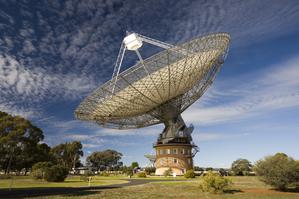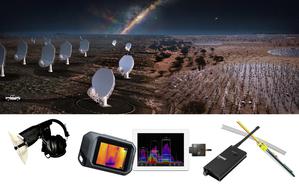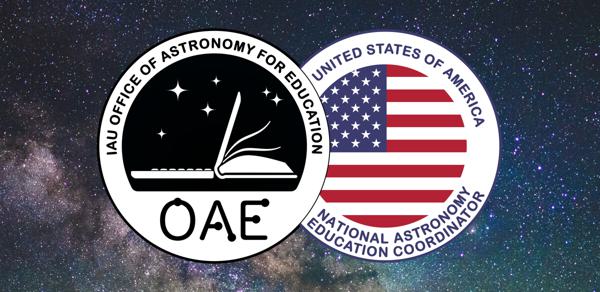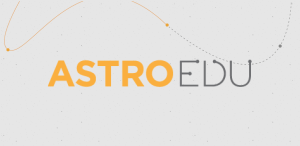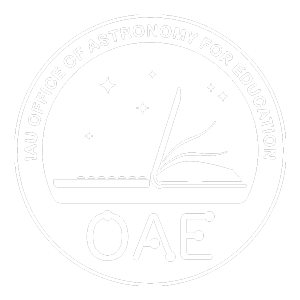Glossarbegriffe: Radioastronomie
Description: Die Radioastronomie ist ein Bereich der Astronomie, der sich mit der Beobachtung von Radiowellen beschäftigt. Radiowellen sind ein spezieller Bereich des elektromagnetischen Spektrums. In der Erdatmosphäre gibt es "Radiofenster": Das bedeutet, dass Radiowellen in bestimmten Frequenz- oder Wellenlängenbereichen die Erdatmosphäre nahezu ungehindert passieren können. Deshalb ist die Beobachtung solcher Radiowellen aus dem All mit bodengebundenen Teleskopen möglich. Typische Beobachtungsfrequenzen reichen von einer Obergrenze von etwa 300 Gigahertz (GHz) bis hinunter zu einigen zehn Megahertz (MHz). Dies entspricht Wellenlängen von 1 mm bis zu einigen zehn Metern. An besonders geeigneten, trockenen und hoch gelegenen Standorten können die Astronomen sogar Submillimeter-Beobachtungen durchführen, bis hinunter zu Wellenlängen von etwa 0,3 Millimetern. Das entspricht Frequenzen von bis zu 1 Terahertz (THz). Die untere Frequenzgrenze bei etwa 10 MHz ist auf die sogenannte Ionosphäre der Erde zurückzuführen. Diese hoch gelegene Region in unserer Atmosphäre enthält zahlreiche geladene Teilchen, die ultralange Radiowellen direkt in den Weltraum zurückwerfen. Mit der Radioastronomie können Astronomen die Emission von kaltem Gas, wie atomarem Wasserstoff und molekularem Gas, in Galaxien und in unserer Milchstraße beobachten. So können sie das diffuse interstellare Medium sowie die Regionen und Prozesse, in denen Sterne und Planeten entstehen, beobachten. Die Radioastronomie ermöglicht auch die Untersuchung hochenergetischer Objekte wie Pulsare und aktive galaktische Kerne: In oder um solche Objekte werden Elektronen in einem starken Magnetfeld beschleunigt, was zur Aussendung von Radiowellen führt. Diese Art von Radiowellen wird auch Synchrotronstrahlung genannt. Pulsare und die sehr hellen aktiven galaktischen Kerne, die als Quasare bekannt sind, wurden mithilfe der Radioastronomie entdeckt. Auch das Überbleibsel der heißen Urknallphase unseres Universums, der kosmische Mikrowellenhintergrund (CMB), wurde mithilfe der Radioastronomie entdeckt. Obwohl Radiowellen aus dem Weltraum erstmals in den 1930er Jahren entdeckt wurden, wurde die Radioastronomie erst nach 1950 zu einem wichtigen Zweig der beobachtenden Astronomie.
Zugehörige Glossarbegriffe:
See this term in other languages
Term and definition status: The original definition of this term in English have been approved by a research astronomer and a teacher The translation of this term and its definition is still awaiting approval
The OAE Multilingual Glossary is a project of the IAU Office of Astronomy for Education (OAE) in collaboration with the IAU Office of Astronomy Outreach (OAO). The terms and definitions were chosen, written and reviewed by a collective effort from the OAE, the OAE Centers and Nodes, the OAE National Astronomy Education Coordinators (NAECs) and other volunteers. You can find a full list of credits here. All glossary terms and their definitions are released under a Creative Commons CC BY-4.0 license and should be credited to "IAU OAE".
If you notice a factual or translation error in this glossary term or definition then please get in touch.
Zugehörige Medien
Parkes Radio Telescope
Bildnachweis: David McClenaghan/CSIRO credit link
License: CC-BY-3.0 Creative Commons Namensnennung 3.0 Unported icons
Related Activities
SKAO and the mysteries of invisible light
astroEDU educational activity (links to astroEDU website) Description: Discover the invisible light with SKAO, the largest radio telescope in the world!
License: CC-BY-4.0 Creative Commons Namensnennung 4.0 International (CC BY 4.0) icons
Age Ranges:
12-14
, 14-16
Education Level:
Informal
, Middle School
, Secondary
Areas of Learning:
Guided-discovery learning
, Observation based
, Technology-based
Costs:
High Cost
Duration:
several days
Group Size:
Group
Skills:
Asking questions
, Constructing explanations
